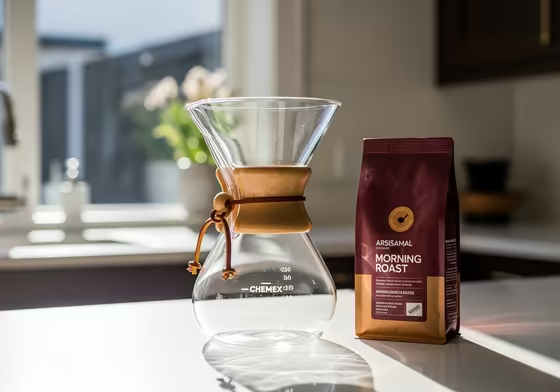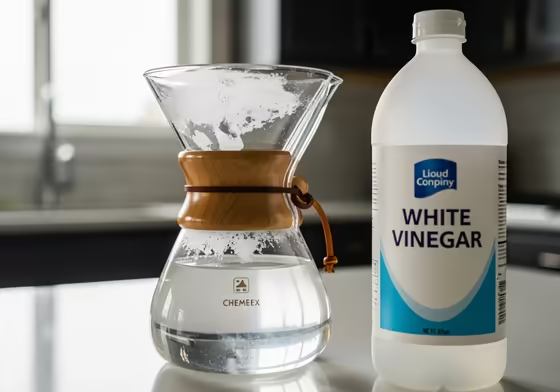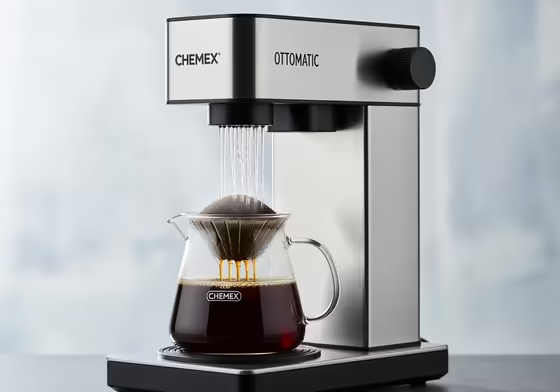How to Keep Your Chemex Clean
The Chemex is known for its cool shape and the clean coffee it makes. It's made of a special glass that doesn't add any flavor. This means you only taste the coffee beans.

But if the glass is dirty, your coffee won't taste pure. This guide shows you how to clean it. It covers everything from a quick daily rinse to a deep clean for tough stains.
Why a Clean Chemex Is Important
Sometimes, new Chemex users say their coffee tastes bad, like burnt or sour. This is usually because of how it was brewed. For example, sour coffee often means it brewed too fast.
Bitter coffee can mean it brewed for too long. A dirty Chemex can cause both of these problems.
- Oily Buildup: Coffee beans have oils that stick to the glass. If you don't clean it, the oil gets old and tastes bad. This old oil will ruin your next cup of coffee.
- Mineral Buildup: If you use hard water, you'll see a white film called scale. This scale means your water has a lot of minerals in it. These minerals can make your coffee taste chalky or bitter. In automatic brewers like the Chemex Ottomatic, this scale can clog the machine and stop the water from getting hot enough.
If you see scale inside your Chemex, it's a warning sign that you're using hard water. Cleaning the scale is only part of the fix. You should also start using filtered or bottled water.
Before you change your coffee grind or how much coffee you use, make sure your brewer is clean. A clean Chemex is the first step to making good coffee.
A Simple Cleaning Schedule
The best way to keep your Chemex clean is to have a schedule. How often you clean it depends on what you're trying to remove.
Table 1: The Chemex Cleaning Cadence
| Frequency | Method | Purpose |
|---|---|---|
| Daily | Hot Water Rinse or Soap & Water | Removes fresh coffee oils. |
| Weekly | Deep Clean with a cleaner like Cafiza | Removes tough, brown coffee stains. |
| As Needed | Deep Clean with Vinegar | Removes white, cloudy mineral buildup. |
Step 1: The Daily Rinse
This is the most important thing you can do. A quick one-minute rinse right after you use it will prevent most future stains. Do it while the glass is still warm.

You can just use very hot water if you do it right away. But washing with a little soap and water is even better.
Is It Okay to Use Soap?
Some people worry that soap will leave a taste behind. This can happen, but that doesn't mean you should avoid soap completely.
Coffee oils don't wash away with just water. You need soap to break down and remove the oils, or a thin film will build up over time.
The "soapy" taste usually comes from scented soaps or not rinsing well enough. The real problem is the fragrance, not the soap. So yes, you should wash your Chemex with unscented soap and rinse it out really well.
Your Daily Cleaning Routine
- Let it cool a bit. Never put a hot Chemex in cold water because it could crack.
- Take off the wooden collar and leather tie before washing. If the wood gets wet a lot, it can warp, crack, or get moldy.
- Add a few drops of unscented dish soap and fill it halfway with warm water.
- Scrub the inside with a long bottle brush. This is a must-have tool because of the Chemex's shape. Make sure you scrub the bottom, middle, and neck.
- Rinse with warm water until all the soap bubbles are gone. The glass should feel squeaky clean.
- Let it air dry, preferably upside down on a rack. Don't put the wooden collar back on until the glass is completely dry.
- You can put the glass part in the dishwasher (without the collar). But washing by hand with a brush usually works better.
Step 2: Deep Cleaning with Vinegar
This is a special deep clean for a specific problem. You don't need to do this every day. Use this method only when you see mineral buildup.

When to Use Vinegar
If your Chemex looks cloudy or has a white film, you have scale from hard water. To remove these mineral spots, you need to use something acidic. Plain white vinegar is cheap and works great for this.
How to Clean with Vinegar
- Take off the wood collar and leather tie.
- Mix one part white vinegar with one part warm water.
- Fill the Chemex with the mix and let it soak for a few hours. For really tough scale, you can leave it overnight.
- Pour out the vinegar mix. Use your bottle brush to scrub off any leftover spots.
- Now, you need to get rid of the vinegar smell. Wash the Chemex with unscented dish soap and warm water.
- Rinse it well and let it air dry.
Does Vinegar Dissolve Coffee Grounds?
People often ask this, but it's about getting rid of grounds, not cleaning. The answer is no, vinegar doesn't really dissolve coffee grounds.
You might see tips online about using vinegar and baking soda to clear a drain. This creates a foam that can loosen a clog, but it doesn't dissolve the grounds. Don't put lots of grounds down your sink.
They can cause serious blockages. It's better to put them in the trash or compost.
Step 3: Getting Rid of Tough Coffee Stains
This is another kind of deep clean, and it's for a more common problem.
When to Use This Method
If your Chemex isn't cloudy but has a sticky, dark brown film, you have old coffee oil stains. Daily soap and water won't be enough to get this off.
We learned that acid (vinegar) fights minerals. But coffee oil is also an acid, so to clean it you need to use an alkaline solution. This is the key to deep cleaning for grease.
Method 1: Salt and Ice
This is a simple trick that doesn't use chemicals. It uses salt and ice to scrub the inside of the glass.

- Put a bunch of ice in your empty Chemex. Add two tablespoons of coarse salt, a few drops of unscented dish soap, and a little water.
- Hold the Chemex and swirl it around fast for a minute or two. The icy, salty mix will scrub the coffee oils off the glass.
- This works well for light or medium oil buildup.
Method 2: Baking Soda
This is a bit stronger than salt and ice. Baking soda can scrub away stains and also helps get rid of smells.
- Put a teaspoon of baking soda and some unscented soap in the Chemex. Fill it with hot water.
- Let it soak for 30 minutes, then scrub it well with your bottle brush. This method can work better than vinegar for hard stains.
Method 3: Professional Coffee Cleaners
This is what you use when your Chemex is really stained. People suggest things like OxiClean, Cafiza, or even denture cleaning tablets.
They all seem different, but they work the same way. When you mix them with hot water, they create hydrogen peroxide to lift stains and a strong degreaser to dissolve coffee oils.
- The Method: Add the cleaner to the Chemex and fill with hot water. Let it soak, and the stains should just flake off. For denture tablets, drop one or two in and let it sit overnight.
- The Final Wash: This is a strong cleaner. You have to scrub and rinse it many times. Then do a final wash with unscented dish soap to make sure no chemicals are left.
Table 2: At-a-Glance: Chemex Deep Cleaning Methods
| Method | Active Agent | Chemical Type | Best For Removing... |
|---|---|---|---|
| Vinegar Soak | Acetic Acid | Acid | White, cloudy mineral stains. |
| Salt & Ice | Salt | Abrasive | Light brown or yellow stains. |
| Baking Soda | Baking Soda | Mild Alkaline / Abrasive | Tougher stains and smells. |
| Cafiza / OxiClean | Sodium Percarbonate | Strong Alkaline | Very dark, set-in stains. |
Step 4: Cleaning Your Filter
People sometimes ask about cleaning Chemex filters. They might be talking about reusable filters. Or they might mean how to get paper filters ready for brewing.

Paper filters are only used once. You prepare them, you don't clean them.
How to Clean Reusable Filters
Reusable filters are great for saving money, but you have to clean them well. They can get clogged with tiny coffee grounds and oils.
-
Cleaning Metal Filters:
- Daily: Right after you brew, dump the grounds. Rinse the filter under hot water and scrub with a soft brush.
- Weekly Deep Clean: To stop clogs, soak the filter in a mix of vinegar and water overnight. The acid helps dissolve the oils.
- For Bad Clogs: If it's really clogged, soak it in a strong cleaner like Cafiza. You could also use a water flosser to blast out the stuck grounds.
-
Cleaning Cloth Filters:
- Daily: Rinse well with hot water only. Never use soap because it will get trapped in the cloth and ruin your coffee's taste.
- Deep Clean: When water flows through it too slowly, boil the filter in a pot of water for 10 minutes. This helps remove the trapped oils.
- Storage: Never leave a wet cloth filter out, or it will get moldy. You can hang it to dry completely. Or, you can store it in a container of clean water in the fridge.
Should You Wet Paper Filters Before Brewing?
Yes, you absolutely should. This is a very important step for brewing good coffee. Some people say it's to wash away a paper taste, but there are more important reasons.
- The main reason is to heat up the brewer. The glass Chemex is big and can cool down your water. Pre-heating it helps keep the water hot enough to brew correctly.
- Rinsing also helps the filter stick to the glass walls. This creates a good seal so the filter doesn't move around.
- Wetting the filter also helps the water flow through the coffee grounds evenly. This makes sure you get all the good flavor out of the coffee.
Here's how to do it. Put the filter in the Chemex with the 3-layer side facing the spout. Pour hot water over it to wet the whole filter and heat the glass. Then, carefully dump the water out before adding your coffee grounds.
Step 5: How to Prevent Problems
This last step is about two things. First is how to stop stains from building up. Second is how to stop your brew from getting clogged.
How to Stop Buildup
The best way to prevent tough stains is to clean your Chemex daily. Just use soap and water right after you brew.
- Get Rid of Grounds the Right Way: Don't wash coffee grounds down the sink because they can clog your pipes. Scrape them into the trash or a compost bin.
- Use Filtered Water: If you have hard water, you will get mineral buildup. The only way to stop this is to brew with filtered or bottled water.
How to Stop a Clogged Brew
It's very frustrating when your coffee just stops dripping through the filter. This makes the brew take way too long, and your coffee will end up tasting bitter.
A stalled brew usually happens for one of three reasons. Here is how to figure out the problem.
-
Check the Airflow: The wet paper can sometimes stick to the glass and create a seal. This "vapor lock" stops air from escaping, so the coffee can't flow down.
- The Fix: This is an easy fix. Always put the 3-layer side of the filter against the spout. This creates an air channel so the coffee can flow freely.
-
Check the Grind Size: If the airflow is fine but it still clogs, your coffee grounds are too fine. The tiny coffee dust is blocking the filter.
- The Fix: Use a coarser grind. The Chemex filter is thick and needs a medium-coarse grind, almost like what you'd use for a French press.
-
Check Your Pouring: If the airflow and grind are right, the problem might be how you pour the water.
- The Problem: Pouring too fast or swirling the coffee too much can cause problems. It makes all the tiny coffee particles sink to the bottom of the filter where they form a thick layer that blocks the water.
- The Fix: Pour the water gently and don't swirl it too much. You can also try pouring the water over the back of a spoon to soften the stream.
Helpful Tools for Cleaning
The Chemex itself is simple, but you'll need a few tools to keep it clean.

-
Daily Tools (You'll need these):
- A long bottle brush with soft bristles.
- Unscented dish soap.
-
Deep Cleaning Tools (Pick one):
- For Scale: White vinegar.
-
For Oils:
- From your kitchen: Baking soda or unscented OxiClean.
- From the store: Coffee equipment cleaners like Cafiza or Urnex.
- For Light Oils: Coarse salt.
- Official Products: Chemex also sells its own cleaning brush and cleaning solution. The solution is mostly for their automatic coffee maker.
More Cleaning Tips
Tips from Coffee Fans
When you look online, you'll see a few common tips for cleaning a Chemex.
- The Salt and Ice Swirl: This is a very popular way to clean light stains without using chemicals.
- The OxiClean Soak: Many people use this for really tough stains. They soak the Chemex in hot water and OxiClean to make it look brand new.
- The Denture Tablet Trick: This one is clever. You just drop a denture tablet in, fill with water, and let it sit overnight for a no-scrub clean.
All these tricks work well because they use the same kind of powerful cleaner. They are great at dissolving old coffee oils.
How to Clean the Chemex Ottomatic
The Chemex Ottomatic is an automatic brewer that needs to be descaled, just like a regular coffee machine. If you don't do this, it could void your warranty.

- How Often: The company says to descale it every 40 brews or every 3 months.
-
Official Instructions:
- Fill the water tank to the 8-cup line.
- Add the official Chemex cleaning solution. Using their product is a good idea to protect the warranty.
- Put the empty Chemex on the hot plate and run a full brew cycle.
- When it's done, throw out the hot cleaning solution.
- Rinse Cycle (Very Important): Fill the tank with clean water and run at least two more full cycles with just water.
- This makes sure no cleaning solution is left behind to ruin your coffee.
- Maintenance: Wipe down the machine with a cloth regularly to keep it clean.